Why Do You Think Art Is Important to People in North America?
Maps have 'northward' at the top, but information technology could've been different

Why are almost all modern maps the same manner up? Caroline Williams explores the intriguing history that led to this orientation – and discovers why it shapes how we see the world in more than ways than we realise.
I
Imagine looking at the Earth from space. What is at the top of the planet? If you lot said the Northward Pole, yous probably wouldn't be solitary. Strictly speaking, yous wouldn't be right either.
The uncomfortable truth is that despite almost everybody imagining that the earth is this way up, in that location is no expert, scientific reason to recollect of due north every bit being the roof of the world.
The story of how it came to be considered to be that mode is heady mix of history, astrophysics and psychology. And it leads to an important determination: it turns out that the manner we take decided to map the world has very real consequences for how nosotros feel about it.
Navigating brain
Understanding where you are in the world is a basic survival skill, which is why nosotros, like virtually species come hard-wired with specialised brain areas to create cognitive maps of our surround. Where humans are unique, though, with the possible exception of honeybees, is that we endeavor to communicate this understanding of the earth with others. We have a long history of doing this by drawing maps – the earliest versions nevertheless discovered were scrawled on cavern walls 14,000 years ago. Homo cultures accept been drawing them on stone tablets, papyrus, paper and at present figurer screens e'er since.
Given such a long history of human map-making, it is perchance surprising that information technology is but within the terminal few hundred years that n has been consistently considered to be at the top. In fact, for much of human history, n almost never appeared at the pinnacle, according to Jerry Brotton, a map historian from Queen Mary University, London and author of A History of the World in Twelve Maps. "North was rarely put at the top for the simple fact that north is where darkness comes from," he says. "West is too very unlikely to exist put at the superlative because w is where the sun disappears."
Confusingly, early Chinese maps seem to cadet this tendency. But, Brotton, says, even though they did have compasses at the time, that isn't the reason that they placed north at the top. Early on Chinese compasses were actually oriented to betoken south, which was considered to exist more desirable than deepest darkest north. Only in Chinese maps, the Emperor, who lived in the due north of the state was always put at the top of the map, with everyone else, his loyal subjects, looking upwards towards him. "In Chinese civilization the Emperor looks s because it'due south where the winds come from, it's a good direction. N is non very expert but you are in a position of subjection to the emperor, so you await up to him," says Brotton.
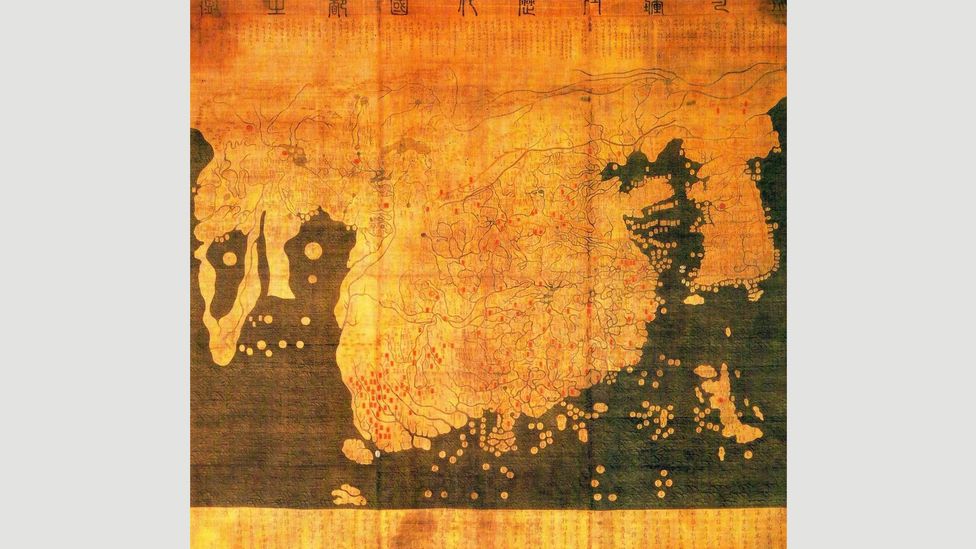
The Kangnido map, a Chinese-influenced Korean map from 1402 (Credit: Wikipedia)
Given that each culture has a very different idea of who, or what, they should look up to it's perhaps not surprising that there is very piddling consistency in which mode early maps pointed. In ancient Egyptian times the top of the world was east, the position of sunrise. Early on Islamic maps favoured south at the top because most of the early Muslim cultures were north of Mecca, so they imagined looking upwardly (south) towards it:
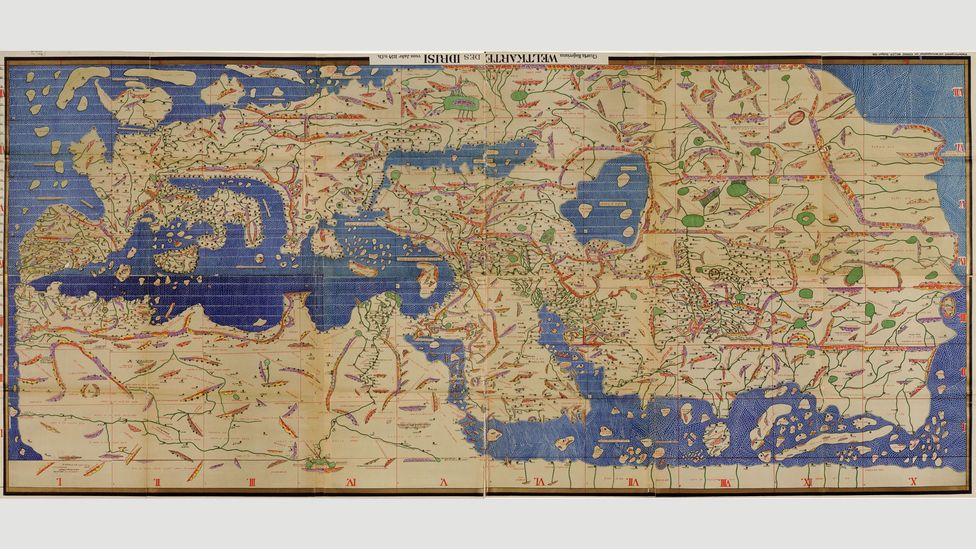
Muhammad Al Idrissi's map Tabula Rogeriana from 1154, upside down with north at the summit (Credit: Wikipedia)
Christian maps from the same era (called Mappa Mundi) put east at the top, towards the Garden of Eden and with Jerusalem in the centre.
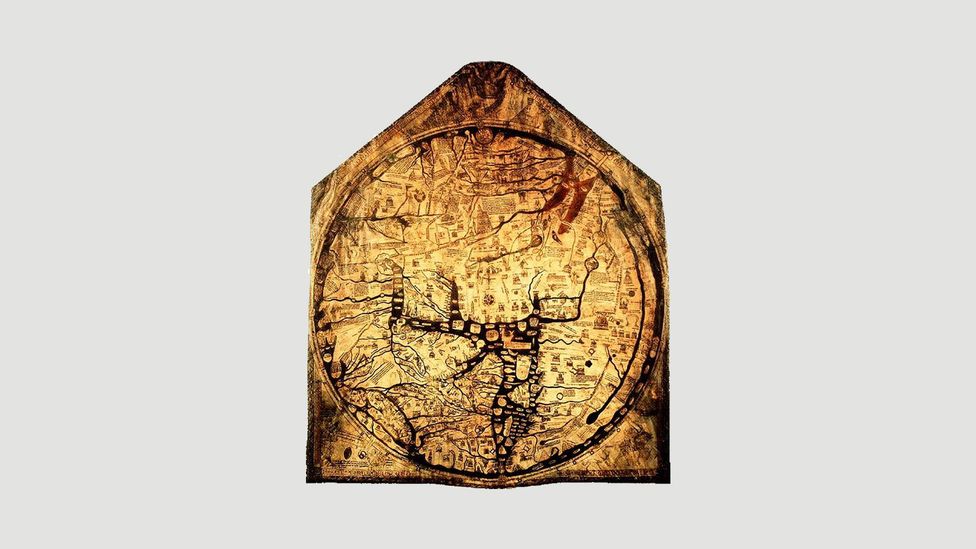
The Hereford Mappa Mundi from 1300 (Credit: Wikipedia)
And then when did everyone become together and decide that north was the height? Information technology's tempting to put it down to European explorers similar Christopher Columbus and Ferdinand Megellan, who were navigating by the North Star. Simply Brotton argues that these early explorers didn't think of the world like that at all. "When Columbus describes the earth it is in accord with east being at the elevation," he says. "Columbus says he is going towards paradise, and so his mentality is from a medieval mappa mundi." We've got to remember, adds Brotton, that at the time, "no one knows what they are doing and where they are going".
Mercator's world map, from 1569, was about certainly a defining moment in north-upwardly map-making. His map was famously the start to accept into business relationship the curvature of the Globe, then that sailors could cantankerous long distances without overshooting the mark. Again, though, Brotton says that north had lilliputian to do with it. "Mercator projected the poles to infinity. He says in his description that it doesn't matter because nosotros are not terribly interested in sailing to them. North is at the height just nobody cares near due north because we're not going there."
Withal, he could have put the map either way up. Peradventure the option was simply considering the Europeans were doing well-nigh of the exploring at the time: in the northern hemisphere, there is far more than land to explore and far more people.
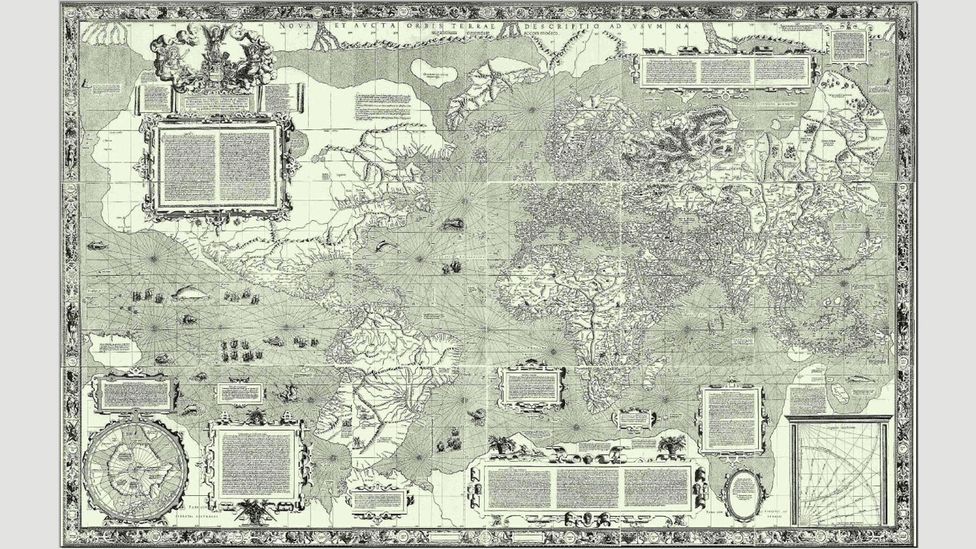
The 1569 Mercator map of the world (Credit: Wikipedia)
Whatever the reasons, north up is an thought that seems to accept stuck. Accept this famous Nasa image from 1973. This photograph was actually taken with south at the meridian, because the astronaut who took information technology was spinning around at the time. Nasa decided to flip it over to avert confusing people.

This image of Earth was photographed this fashion round, merely flipped before publication (Credit: Nasa)
When you commencement looking at the Globe from infinite though, the idea of it being whatsoever particular way upwards starts to brand even less sense. It's true that, as we all learned in schoolhouse, the Globe lines up forth the same aeroplane as all of the other planets in the solar system because they all formed out of the same cloud of spinning grit. It is likewise truthful, though, that this picture could just as easily be put upside downward or with the Sunday at the pinnacle or bottom, depending on where in space you lot happen to be looking from.

And compared to the rest of the Milky Fashion, our unabridged solar system is off kilter by most 63 degrees.
While astronomers accept plant that stars and planets align with their neighbours in similar ways all over space, Daniel Mortlock, an astrophysicist at Majestic College London, says that this is only truthful at a tiny calibration compared to the vastness of the Universe. "As far as we astronomers can tell, there really is no 'upwards' or 'down' in space," he says.
So the answer to the question of which style up is the Globe is simple: it is not whatever particular way upwardly and there is no adept reason other than a historical superiority circuitous to call up of north as being the top of the earth.
Nevertheless is it time to first embracing a different view of the planet from the one we are used to? Possibly, because evidence from psychology suggests that our north-up civilisation might exist polluting the way nosotros think of what is valuable in the world.
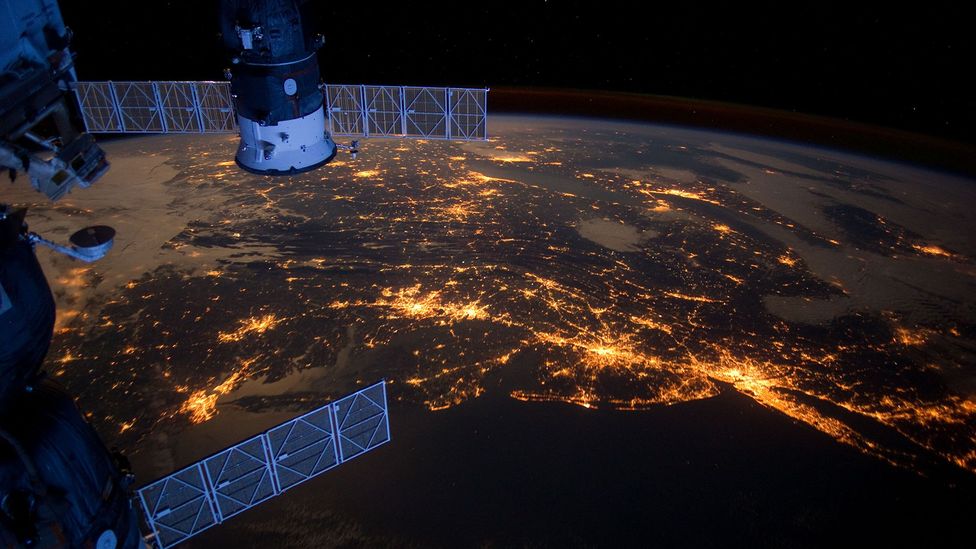
Could in that location be a northern bias that shapes how we think well-nigh some parts of the planet? (Credit: Nasa)
A well-known bias in psychology reveals that nearly people retrieve of north as being 'up' and s, 'down'. Brian Meier, a psychologist at Gettysberg College in Pennsylvania, has likewise constitute that people unconsciously procedure positive words equally if they were higher in space than negative ones. Then he wondered whether these ii things, north = up and practiced = upwardly affect the value that people put on unlike areas on a map.
Sure enough, when shown a map of a hypothetical city and asked where they would like to live, people were significantly more likely to choose an area in the due north of the urban center. And when another group of people were asked where fictitious people of dissimilar social status would live, they plotted them on the map with the richest in the due north and poorest in the due south.
It isn't as well much of a stretch to think that people are less likely to care what happens in countries or regions that are 'lower' than them on the map or world.
The good news is that in Meier'southward experiments the relationship between 'north' and 'good' was eliminated past 1 simple thing – turning the map upside downwardly. So maybe the earth might get a trivial fairer if we just took a look at it another way up now and once more. South-up maps are easily available online. It is also something that Mortlock is very much in favour of: "Every bit an Australian, I think it should exist washed more often," he says.
If zero else, it's a sure-fire way to brand the world seem fresh, and unexplored, once more. With and so few earthbound discoveries left for our generation to brand, all we tin do is – to paraphrase Marcel Proust – expect again at the world we've got, merely this time, through different eyes.
Bring together 600,000+ Future fans by liking us onFacebook , or follow us onTwitter ,Google+ ,LinkedInandInstagram .
If yous liked this story, sign up for the weekly bbc.com features newsletter , called "If You Simply Read 6 Things This Week". A handpicked selection of stories from BBC Hereafter, Earth, Culture, Majuscule, Travel and Autos, delivered to your inbox every Friday.
Source: https://www.bbc.com/future/article/20160614-maps-have-north-at-the-top-but-it-couldve-been-different
0 Response to "Why Do You Think Art Is Important to People in North America?"
Post a Comment